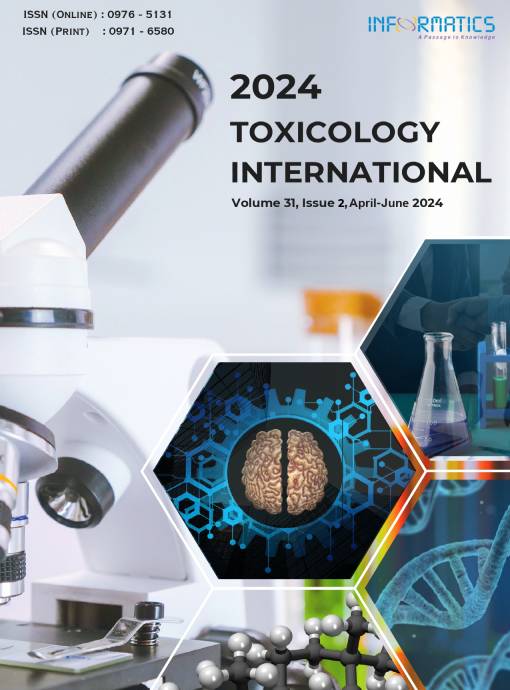Molybdenum-Induced Oxidative Stress and Histopathological Alterations in the Epididymis
DOI:
https://doi.org/10.18311/ti/2024/v31i2/34727Keywords:
Antioxidants, Epididymis, Histology, Molybdenum, RatsAbstract
Molybednum is one of the trace elements required for proper functioning of the human body. The present study was designed to assess the effects of molybdenum on accessory reproductive organ i.e. epididymis. Male Wistar rats were administered with three different doses of molybdenum (50, 100 and 150 mg/kg body weight) for 60 days. A recovery study was also conducted in the highest dose group for which half the animals of the group were left untreated for the next 60 days. Exposure to molybdenum induced a significant decline in superoxide dismutase, ascorbic acid and glutathione while lipid peroxidation revealed a significant increase in epididymis in dose-dependent manner. Significant reduction in epididymal epithelial cells height, short sterocilia, increased intertubular stroma, decreased epididymal sperm reserve in the lumen and reduction in the diameter of cauda epididymal tubules with a relatively large amount of intertubular stroma was observed in epididymis of mice treated with molybdenum which might be correlated with enhanced oxidative stress. In the recovery group, significant improvement in antioxidant parameters and histoarchitecture of epididymis was observed indicating toxic effects of molybdenum can be reversed by cessation of exposure.
Downloads
Published
How to Cite
Issue
Section
License
Copyright (c) 2024 Geeta Pandey, G. C. Jain

This work is licensed under a Creative Commons Attribution 4.0 International License.
Accepted 2024-03-16
Published 2024-05-09
References
Senger PL. Pathways to Pregnancy and Parturition. 2nd ed. Current Conceptions Inc; 2003.
Woodruff TJ, Jansen S, Giullette LJ, Guidice LC. Environmental impacts on reproductive health and fertility, New York: Cambridge University Press; 2010.
Sengupta P. Environmental and occupational exposure of metals and their role in male reproductive functions. Drug Chem Toxicol. 2013; 36(3):353-68. https://doi.org/10.3109/ 01480545.2012.710631 DOI: https://doi.org/10.3109/01480545.2012.710631
Balali-Mood M, Naseri K, Tahergorabi Z, Khazdair MR, Sadeghi M. Toxic mechanisms of five heavy metals: mercury, lead, chromium, cadmium, and arsenic. Front Pharmacol. 2021; 12:643972. https://doi.org/10.3389/ fphar.2021.643972 DOI: https://doi.org/10.3389/fphar.2021.643972
Nielsen FH. Trace and ultratrace elements, reference module in biomedical sciences. Elsevier; 2014. https://doi. org/10.1016/B978-0-12-801238-3.00235-X DOI: https://doi.org/10.1016/B978-0-12-801238-3.00235-X
Ohkawa H, Ohishi N, Yagi K. Assay for lipid peroxide formation in animal tissues by thiobarbituric acid reaction. Anal Biochem. 1979; 95:351-8. https://doi. org/10.1016/0003-2697(79)90738-3 DOI: https://doi.org/10.1016/0003-2697(79)90738-3
Marklund S, Marklund G. Involvement of the superoxide anion radical in the autoxidation of pyrogallol and a convenient assay for superoxide dismutase. Eur J Biochem. 1974; 47:469−74. https://doi.org/10.1111/j.1432-1033.1974. tb03714.x DOI: https://doi.org/10.1111/j.1432-1033.1974.tb03714.x
Moron MJ, Depieare JW, Mannivik B. Levels of glutathione reductase and glutathione transferase activities in rat lung and liver. Biochem Biophys Acta. 1979; 582:67-8. https:// doi.org/10.1016/0304-4165(79)90289-7 DOI: https://doi.org/10.1016/0304-4165(79)90289-7
Roe JH, Kuether CA. Determination of ascorbic acid in whole blood and urine through the 2,4-DNPH derivative of dehydroascorbic acid. J Biol Chem. 1943; 147:399-407. https://doi.org/10.1016/S0021-9258(18)72395-8 DOI: https://doi.org/10.1016/S0021-9258(18)72395-8
Nasreldin M I, Leona GY, Otto F. Epididymal specificity and androgen regulation of rat EP2. Biology of Reprod. 2001; 65(2):575-80. https://doi.org/10.1095/biolreprod65.2.575 DOI: https://doi.org/10.1095/biolreprod65.2.575
Cornwell GA. New insights into epididymal biology and function. Hum Reprod Update. 2009; 15 (2):213-27. https:// doi.org/10.1093/humupd/dmn055 DOI: https://doi.org/10.1093/humupd/dmn055
Pandey R, Singh S. Effects of molybdenum on fertility of male rats. Biometals. 2002; 15:65–72. https://doi. org/10.1023/A:1013193013142 DOI: https://doi.org/10.1023/A:1013193013142
Lyubimov AV, Smith JA, Rousselleb SD, Merciecab MD, Tomaszewskic JE, Smith AC, Levinea BS. The effects of tetrathiomolybdate (TTM, NSC-714598) and copper supplementation on fertility and early embryonic development in rats. Reprod Toxicol. 2004; 19:223–33. https://doi.org/10.1016/j.reprotox.2004.07.006 DOI: https://doi.org/10.1016/j.reprotox.2004.07.006
Hamzeh M, Robaire B. Effect of testosterone on epithelial cell proliferation in the regressed rat epididymis. J Androl. 2009; 30(2):200-12. https://doi.org/10.2164/ jandrol.108.006171 DOI: https://doi.org/10.2164/jandrol.108.006171
Pandey G, Jain GC. Assessment of molybdenum induced alteration in oxidative indices, biochemical parameters and sperm quality in testis of Wistar male rats. Asian J Biochem. 2015; 10:267-80. https://doi.org/10.3923/ajb.2015.267.280 DOI: https://doi.org/10.3923/ajb.2015.267.280
Bui A, Sharma R, Henkel R, Agarwal A. Reactive oxygen species impact on sperm DNA and its role in male infertility. Androl. 2018; 50(8):e13012. https://doi.org/10.1111/ and.13012 DOI: https://doi.org/10.1111/and.13012
Hussain T, Kandeel M, Metwally E, Murtaza G, Kalhoro DH, Yin Y, Tan B, Chughtai MI, Yaseen A, Afzal A, Kalhoro MS. Unraveling the harmful effect of oxidative stress on male fertility: A mechanistic insight. Front Endocrinol. 2023; 14:1070692. https://doi.org/10.3389/fendo.2023.1070692 DOI: https://doi.org/10.3389/fendo.2023.1070692
Zhai XW, Zhang YL, Qi Q, Bai Y, Chen XL, Jin LJ, Ma XG, Shu RZ, Yang ZJ, Liu FJ. Effects of molybdenum on sperm quality and testis oxidative stress. Syst Biol Reprod Med. 2013; 59(5):251-5. https://doi.org/10.3109/19396368.2013. 791347 DOI: https://doi.org/10.3109/19396368.2013.791347
Volodymyr IL. Glutathione homeostasis and functions: Potential targets for medical interventions. Journal of Amino Acids. 2012; 2012:736837. https://doi. org/10.1155/2012/736837 DOI: https://doi.org/10.1155/2012/736837
Sasmal N, Kar NC, Mukherjee D, Chatterjee GC. The effect of molybdenum on ascorbic acid metabolism in rats. Biochem J. 1968; 106(3):633–7. https://doi.org/10.1042/ bj1060633 DOI: https://doi.org/10.1042/bj1060633
Foley GL. Overview of male reproductive pathology. Toxicol Pathol. 2001; 29(1):49–63. https://doi. org/10.1080/019262301301418856 DOI: https://doi.org/10.1080/019262301301418856
Guyonnet B, Dacheux F, Dacheux JL, Gatti JL. The epididymal transcriptome and proteome provide some insights into new epididymal regulations. J Androl. 2011; 32:651-64. https://doi.org/10.2164/jandrol.111.013086 DOI: https://doi.org/10.2164/jandrol.111.013086
 Geeta Pandey
Geeta Pandey







